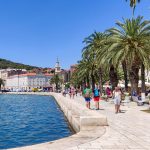Here in Croatia, he’s known as a political activist, a whistleblower and as a skilled computer hacker, but that isn’t all this talented Croat is about. Denis Periša, a computer genius who hails from the Dalmatian city of Šibenik is the man who built a free internet network in the city, and is also a priceless employee who works with the police in successfully searching for cyber criminals.
As Morski/Jurica Gaspar writes on the 8th of October, 2019, the ever-talented Denis Periša has come up with the idea for a device intended for search and rescue missions out at sea. This very topic was discussed back in summer, but in the meantime, it was precisely the drama around the search for another Croat lost at sea, Dino Miškić, that progressed Denis’ tool that could make such situations unnecessary in the future, and save many lives with the help of cheap and very easily accessible technology.
”I’m sorry that more people aren’t involved with microcontrollers and what is currently the best LoRaWAN network available in the whole of Šibenik and its surroundings. Šibenik is the first city in the region to give people that to use and develop.
To put together what we were talking about, it would be some kind of small microcontroller that, in the couple of instances where submersion [of a vessel] really ends up occurring, would activate the GPS and a beacon, and later on, a SAR ship could go out on the high seas where it’s easily reachable, even if it’s fifty kilometres away [from the sinking vessel]. When it comes to designing and testing this device out, I’d easily be able to install the application on all MUP vessels,” stated Denis, with an introductory story about his idea.
”The device could be smaller. This first and largest is a microcontroller with a lot of unnecessary nonsense, so it’s obviously bigger. That’s the brain. You program it to work with these two sensors, for example, in certain conditions. Next to it is a LoRa communication chip, and to the right is, let’s say, a gyroscope, or it can be a moisture sensor and/or a GPS system. Everything is soldered to one another, the case is printed out and that’s the concept. Later, this is sent to the factory and all of it is put on one small plate,” explained Denis.
And how does this work in the wake of a sinking ship with a crew on board?
”Well, however you can imagine. It just needs an idea. Let’s say a moisture sensor and a gyroscope – to detect a sudden rolling over and the presence of water, in that way we can be sure someone is in trouble. From being in standby mode, the GPS wakes up and sends the ship’s location via the LoRa system. This type of technology is very accessible nowadays. So, it could be a scenario that this set of sensors is connected to a life raft and let’s say one of the sensors, specifically the one next to the red one that will, for example, measure the altitude and if that altitude goes down, to trigger an emergency beacon that will send out the vessel’s GPS position.
It’s clear to me that not everyone can do this, and some don’t have access to it, but the fact that life rafts don’t have something like this is unacceptable. This could have saved lives,” concludes this innovative Croat, showing some miniature chips worth about fifty kuna, which could be sewn onto the seafarer’s clothing, reducing potentially tragic search and rescue missions in future to the shortest possible time, thus saving lives.
Make sure to follow our dedicated Made in Croatia page for much more.








